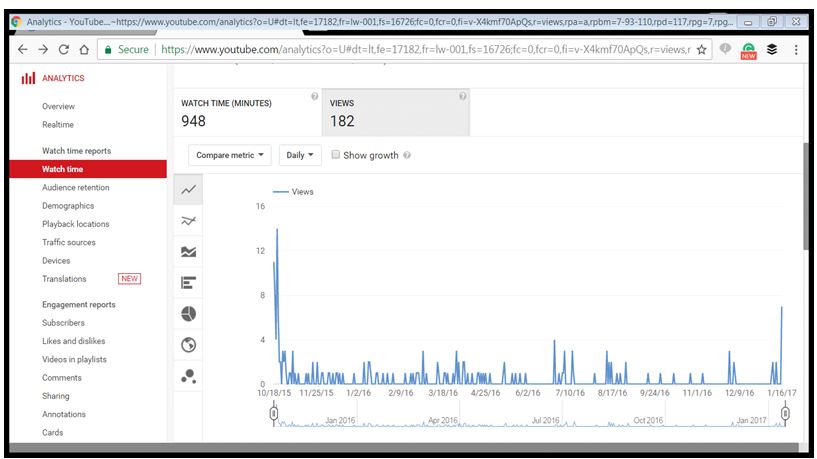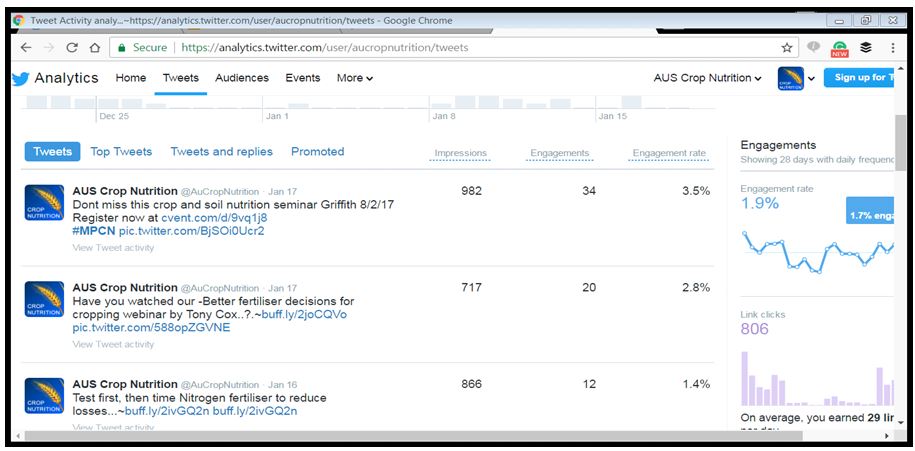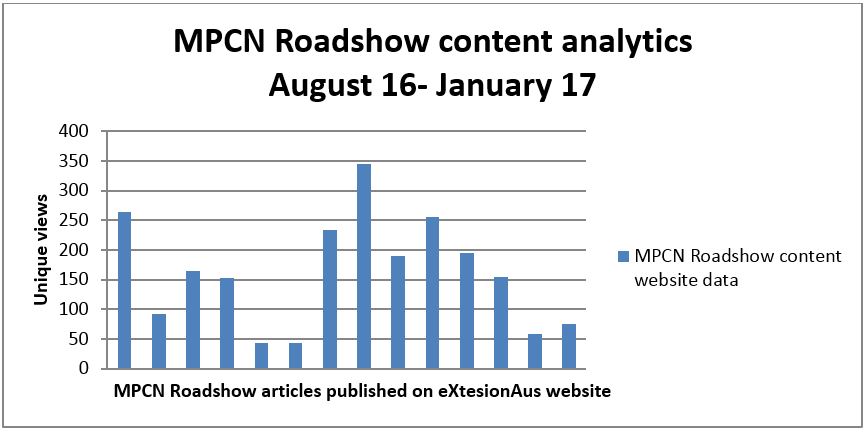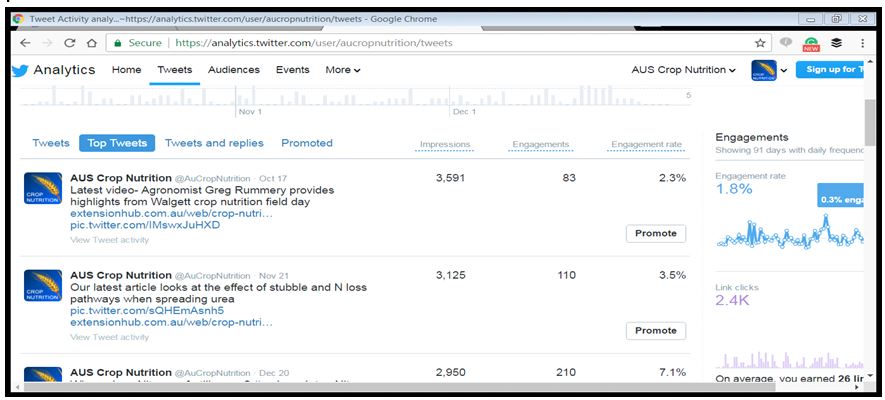MPCN achievements and outcomes- & eXtensionAUS- How do we get new science to growers?
Author: Tony Cox and Fleur Muller, NSW Department of Primary Industries | Date: 28 Feb 2017
More Profit from Crop Nutrition phase II (MPCN ll) is a National Program that has been operating since 2012. It is active in the North, West and South grain regions and was set up with specific aims.
These aims were to improve investment from fertiliser inputs by;
- Improving the nutrient efficiency of crops
- Improving the capacity of soils to supply nutrients
- Reducing the soil's propensity to lose or lock up nutrients
- Develop improved fertiliser product formulation and design including the use of potentially valuable, low cost and waste inputs
MPCN had goals which were:
- Increased adoption of nutrition knowledge across Australia
- Improved coordination of communication and extension across the grains and fertiliser industries - a need to develop stronger linkages
- Improved tools that are used by grain growers and advisors to improve nutrient use efficiency
- Documentation of emerging ideas and capacity challenges
MPCN was divided into 6 program themes:
- Make nutrient use efficiency traits available to plant breeders in adapted backgrounds
- Better match N,P,K and S inputs to meet crop demand and minimise losses and tie-up
- Make better use of micro-nutrients to correct deficiencies and enhance crop yield
- Develop and test new fertiliser products and adjuvants
- Provide information to growers to make effective fertiliser decisions
- Coordination of a program with a lasting legacy of analysed, reported and published information
The 33 individual projects have influenced grain production outcomes across the three regions as well as had an impact with the fertiliser industry. A major driver of the initiative has been the coordination of the program by NSW DPI. Part of this coordination has allowed annual workshops to be held where researchers are able to present their work to the funding body GRDC as well as their peers. This has enabled an on-going review of their science and a level of collaboration not seen in the grains research industry before.
The research findings have enabled industry to have confidence in the critical nutrient ranges that underpin DSS tools in the fertiliser industry as well as give agricultural consultants and grain growers access to the latest research occurring nationally.
The program has also enabled junior researchers to access to the senior scientists within Australia and a sharing of corporate science knowledge and methodologies Australia wide. The annual workshop has enabled the scientists and GRDC to be able to have open and frank discussions about their research and challenges that they have faced. It has taken five years to get to this stage but it has enabled the crop nutrition-soil science community to be able to engage and network.
MPCN has a Program Advisory Committee which (PAC) which is chaired by Dr Mike McLaughlin from the GRDC Southern Panel and has other membership from GRDC and the fertiliser industry. The PAC reviews the progress of research after each annual conference and recommendations are made in reference to mentoring a researcher or making changes to research methodologies. These are then implemented by the Coordinator to result in a better outcome for the Australian grains industry.
The role of the Coordinator is also to help coordinate extension across the regions and overview the research and establish where it can be utilised Australia wide. For example, research findings from the West may have relevance to the grains industry in the North and as such there is a need to have extension activities incorporating these key messages planned and developed.
Approximately every second year, a crop nutrition MPCN supplement is coordinated and published in GroundCover. This is achieved by working with the researchers and extension teams in each region to publish the key findings and outcomes based on the 6 themes. Extension activities are run by the extension teams in each region. DAFWA in the West is coordinated Dr Angelo Loi, Birchip Cropping Group in the South is coordinated by Louisa Ferrier and in the North by Dr Kaara Klepper from DAF. The extension teams and Coordinator work very closely with eXtensionAus in delivering the key messages.
Extension activities
The 1300 extension activities Australia-wide use varied methodologies including field walks, webinars, formal presentations, workshops, newsletters, fact sheets, GroundCover supplements, radio and eXtensionAus. They deliver the key messages from MPCN ll on how to be more profitable in your farming system.
eXtensionAus has joined with MPCN ll in the last two years. The MPCN ll program has utilised eXtension to disseminate key messages to growers and consultants, particularly with the support tool from the Better Fertiliser Decision for Cropping project. BFDC has undergone some major functionality changes and the project has utilised eXtension to deliver these messages to industry
MPCN research achievements have included some great research outcomes with value to the Western region but have implications for the other GRDC regions as well these.
Locally some great outcomes from MPCN research have been presented at the GRDC Updates and these include
- Dr Richard Bell's work on Potassium and Frost stress and Clay Nutrition research
- Dr Ross Brennan's work on micro-nutrient deficiencies
- Dr Louise Barton's Nitrogen fertiliser response curve research
- Dr Craig Scanlon's work with Regional soil testing guidelines with a focus on N, P and lime interactions
- CSIRO and their research in N, P, K and S interactions
- Dr Roger Lawes' research in the value of fixed N
The crop nutrition supplements that have been published in GRDC GroundCover highlight a lot of this work and it has been presented locally at the GRDC updates.
Nationally, research through MPCNII has achieved outcomes through the following work.
- Dr Tim Cavagnaro and Dr Sean Mason - P rates to accompany high N rates
- Dr Victor Sadras - Benchmarking yield against N use
- Dr Mark Conyers - Regional soil testing guidelines
- Dr Mike Bell - Regional soil testing guidelines K, P and S
- Ass/Prof Chris Guppy - Evaluating testing methods for P and K reserves
- Dr Roger Armstrong - Improving Nitrous oxide abatement in HRZ
- Dr Sean Mason - Nutrient Stratification and sub-surface soil testing
- Dr Victor Sadras - N and water interactions
- Dr Mike Bell - Deep placements of Nutrients
- Ass/Prof Chris Guppy - Variation in Northern wheat, barley and chickpea in response to N, P, K and S
- Dr Manny Delhaize - Puse efficiency Rhizosheath Project
- Chirag Mehta / Damian Batstone - Fertiliser from waste
- Therese McBeath and Dr Mike McLaughlin - P foliar applications
- Tony Cox - Better Fertiliser Decisions for Cropping Systems
- Kaara Klepper - Extension North
- Louisa Ferrier - Extension South
- Angelo Loi - Extension West
- Julie White and Fleur Muller - eXtensionAus
- Tony Cox - Coordination
BFDCII Better fertiliser decision for cropping tool has benefited from MPCNII in being able to utilise this research and present it in the form of data to industry. BFDC has been able to deliver soil test crop response calibration curves for all soil types in Australia and all grain crops. This enables industry to be able to have confidence in the science underpinning BFDC and providing confidence in the ability to make better fertiliser decisions which can provide increased yield and better profit to growers.
This research has been presented nationally at GRDC updates and in the GRDC GroundCover magazine which there are copies of at the MPCN ll stand in the Hall. Many of the researchers are here today and I encourage you to approach them to discuss their research or I am more than happy to discuss their findings at the MPCN ll stand.
Key messages
- Non-traditional extension methods are being used to make the latest crop nutrition research more accessible to Australian growers and advisors.
- Online communication technology and social media can be effective tools to connect growers and researchers together and to break down time and distance barriers normally associated with traditional face to face extension.
- Web-based tools such as the Better Fertiliser Decision for Cropping Systems in Australia (BFDC) Interrogator can be readily demonstrated via webinars and YouTube clips that can also provide an ongoing legacy for the project.
Background
The digital age is changing the face of Australian agriculture and the way grain growers access information for decision making. A rapid expansion of online information and communication technology applications in agriculture has seen growers increasingly turning to web-based information sources.
This digital space offers huge potential in terms of connecting growers to researchers and evidenced-based information, decision support tools and networks of likeminded people. Traditional extension methods can be costly. Rather than replacing traditional methods of extension such as face to face meetings, online tools such as YouTube and twitter can complement existing extension programs.
The online space can also foster greater collaboration between researchers and research projects. A collaborative relationship between GRDC funded projects- More Profit from Crop Nutrition ll, Making Better Fertiliser Decisions for Cropping Systems in Australia (BFDC) and eXtensionAUS (Crop Nutrition), is supporting Australian grain growers and advisors to make improved crop management decisions by providing greater access to reliable science-based crop nutrition research and the best verified trial information on most nutrients by location.
Aims
eXtensionAUS is an online learning network connecting Australian grain growers and advisors to the latest crop nutrition and field crop disease information and advice and brings together Australia’s leading experts in crop nutrition and field crop disease. It provides a national source of evidence-based information and uses online tools to reach people and link them to the latest information and research.
New extension methods
In 2015, eXtensionAUS Crop Nutrition conducted a webinar titled “Crop nutrition and better fertiliser decisions for cropping”. Presented by Tony Cox, National Coordinator for the More Profit from Crop Nutrition II program, on 8 October, the webinar introduced the BFDC database and the Interrogator to crop advisors to ensure their fertiliser recommendations are underpinned by the best available science.
The event was promoted via the eXtensionAUS Crop Nutrition twitter account- (twitter handle @Auscropnutrition), the eXtensionAUS website and emails to crop nutrition networks. Over 100 registrations were received prior to the webinar, with 61 attendees joining online on the day. The webinar recording was subsequently published on the eXtensionAUS Crop Nutrition Youtube channel, and was further promoted via the website and twitter. Since being published, an additional 182 people have accessed the webinar. Figure 1 below shows the number of times the webinar has been clicked on and the total time viewing time to date (Jan 2017).

Figure 1. YouTube analytics for the lifetime of the Better Fertiliser Decisions webinar.
Utilizing the YouTube channel to publish the webinar recording makes it easily accessible for viewers and also provides an ongoing resource that can be further leveraged at different times of the year. Figure 2 below shows how a simple tweet relating to the BFDC webinar can bring the project back into focus. While this one off tweet received a relatively low level of engagement with 20 people clicking on it to view more detail, it still triggered additional views on the webinar as shown by the spike in Figure 1 in Jan 2017.

Figure 2 Tweet to promote the BFDC webinar on the eXtensionAUS Crop Nutrition YouTube channel.
Webinars are a cost effective way to host an event and can overcome the challenge of getting people to take time away from the farm to attend face to face workshops. They provide an opportunity to connect with a large audience spread across the country without the need to travel, hire meeting rooms or organise catering. The uptake of the BFDC webinar highlighted that farmers and advisors are willing to participate in online events targeted to their needs and that provide the flexibility to access the content when it is most convenient.
MPCN roadshow
In July and August 2016, the More Crop from Crop Nutrition II initiative undertook a series of on-farm workshops with the aim of presenting the most recent soil and plant nutrition research and local nutrition strategies from the current projects. Four workshops were held across Northwest NSW and three in Southern NSW and these provided an opportunity to hear from the experts and for interaction and discussion between grain growers and researchers. eXtensionAUS Crop Nutrition provided support to these events by promoting details via twitter and the website prior to these events. Regional agronomy advisors also attended a number of the Northern and Southern NSW events, where they gathered content and tweeted many key messages.
These on-the-go tweets were a cost effective way to further extend key messages beyond those attending the workshops, further showcasing the work of the MPCN II initiative. These tweets gained significant traction with grain growers, advisors and researchers who follow @AUS Crop Nutrition (currently around 2500 followers) and beyond with over 4500 people seeing the tweet in their twitter feed, more than 200 people interacting with the tweet and 13 re-tweets. (Figure 3)

Figure 3 Example of MPCN roadshow tweet (top) and associated analytics (bottom)
A series of twelve articles and three videos were developed and published following the roadshows. The articles were prepared in response to discussions between growers, advisors and researchers observed at the Roadshows and featured many of different aspects of crop nutrition in the Australian grains industry. These have been published on the website and YouTube channel and are clearly branded as Roadshow content. All of these articles were prepared with, and reviewed by members of our Community of Practice, and the MPCN extension staff.

Figure 4 shows the web page hits for these articles to date, including one which ranked as the second most viewed article overall on the Crop Nutrition website for July-December 2016
Figure 4 MPCN Roadshow article showing website traffic
Toolbox
Online tools such as twitter, websites and YouTube can all work hand in hand to help target the specific information needs of audience segments. A well-structured tweet can quickly provide a take home message and when combined with a link to a website or YouTube channel can cater for those users seeking more in-depth information. Analytics provided by online platforms can provide useful insights into audience use and preferences.

Figure 5
The future
Non-traditional extension methods have helped to make the latest crop nutrition information more accessible to growers and advisors who are time poor. While the online world offers fast and easy access to information from around the world, it is crowded place and it can be hard to find reliable and up-to-date information. The collaboration between eXtensionAUS Crop Nutrition, MPCN II and BFDC ll has provided growers and advisors with a source of credible information and tools to make more profitable crop nutrition decisions.
Acknowledgements
The research undertaken as part of this project is made possible by the significant contributions through both trial cooperation and the support of the GRDC. The authors would like to thank them for their continued support.
Was this page helpful?
YOUR FEEDBACK
